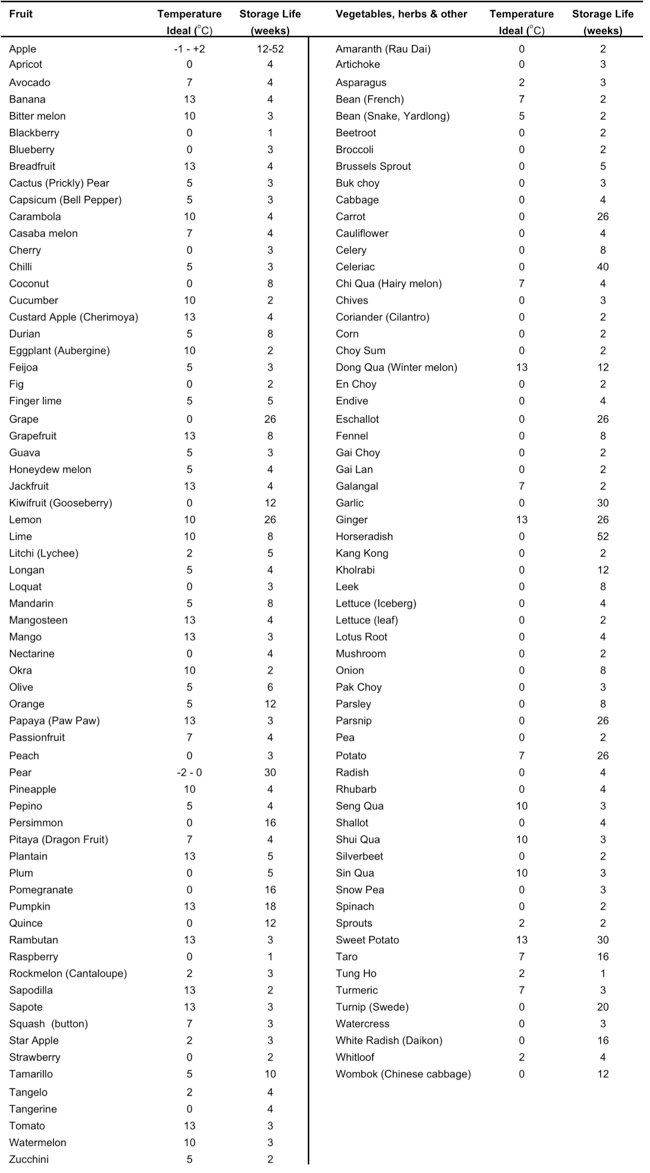training - consulting - facilitating

get answers to some common questions


Storage temperatures for fruits and vegetables
Harvested fruit and vegetables are living organisms. They maintain many of the biochemical reactions and physiological systems they operated when attached to the growing plant. They respire (breathe) by absorbing oxygen and emitting carbon dioxide and heat plus they lose water (as this can no longer be replaced from the growing plant). The harvested produce relies on it’s own sources of energy and water to survive until it’s final consumption.
Different types of fresh produce have different abilities to survive and maintain their quality. Some types have very short storage lives because they have high metabolic rates and high rates of water loss and must be kept under cool, humid conditions. Other types with low metabolic rates and low rates of water loss can be stored for long periods of time without the need for cool storage. Knowing the characteristics of the living produce can assist with decisions about managing storage and minimising deterioration prior to consumption.
Fruit versus vegetables
Fruit are the reproductive organs of the plant and continue to develop (ripen) when detached from the plant. Their ripening program may not be completed if the handling and storage conditions disrupt the program. Excess heat or cold may inactive essential enzymes required for ripening to progress or cause temperature injury, resulting in permanent loss of eating quality.
Vegetables are the leaves, stems and roots of plants that are harvested when they have achieved the qualities required. Unlike ripening fruit, they generally do not undergo dramatic changes after harvest, although they continue to function as living organisms (e.g. a hydroponic lettuce is still a growing plant with roots and leaves, an onion or potato can re-sprout and grow into a new plant under the right conditions). They need to be kept under the right conditions to minimise quality loss.
Variables affecting storage life
Key variables affecting the storage life and eating quality of fruit and vegetables are:
-
•time from harvest
-
•temperature
-
•relative humidity
-
•atmosphere composition
-
•ethylene
-
•pest and disease
-
•pre- and postharvest treatments
Time from harvest is a key determinant for many fresh produce types, particularly leafy green vegetables, mushrooms and berry fruit. Products with high metabolic rates and water loss deteriorate rapidly and have short storage life capabilities. Postharvest research has identified the optimum storage conditions required for all the different types of produce and maintaining these conditions along the supply chain will ensure minimal loss in quality.
Temperature is a key determinant of chemical reaction rates and, therefore, produce metabolic rates. Perhaps the most important factor in extending the storage life for most fresh produce types is correct temperature management. Because fresh produce is a living organism this does not always mean that the lower the temperature the longer the storage life. Produce quality can be irreversibly damaged by applying the wrong temperature.
When detached from the growing plant fresh produce continues to transpire and lose water. Maintaining high relative humidity in the storage atmosphere will minimise water loss, although in practice this can be difficult to achieve depending on air exchange rates. Most refrigeration systems operate at low relative humidity which has a rapid drying effect. Fresh produce cooling facilities need to be specially designed to provide water vapour management at a high relative humidity
Controlled atmospheres and modified atmospheres are strategies designed to control the metabolic rates of fresh produce through altering the composition of atmospheric gases in contact with the produce. They create high carbon dioxide/low oxygen atmospheric concentrations relative to normal atmospheric concentrations. For example, controlled atmospheres for many apple varieties range in the concentrations of 2-5% carbon dioxide / 2-3% oxygen, compared to normal atmospheric concentrations of 0.04% carbon dioxide / 21% oxygen. Increasing carbon dioxide concentrations and reducing oxygen concentrations has the effect of slowing respiration rates, but needs to be closely monitored and controlled along with temperature to ensure any negative effects on quality are avoided.
Ethylene is a gaseous plant hormone that affects many plant biochemical reactions and physiological functions. It is produced by plants and plants can also be affected by exposure to external sources. Minimising exposure to ethylene will extend the storage life of most fresh produce types. For more information about ethylene and it effects on fresh produce see Fruit ripening gas - ethylene
Pest and disease presence will accelerate the deterioration of fresh produce after harvest through damage to plant tissues. Damaged tissues will emit ethylene or act as reservoirs for the spread of infection of other stored produce. Hygiene and sanitation of packing and storage facilities plus application of registered pre and postharvest treatments to control pest and disease should be conducted prior to storage.
Guideline temperatures for storing fresh produce and expected storage life
The storage temperatures and times provided below are for general guidance only.
Plant breeding continues to provide fresh produce industries with new varieties that may have different characteristics for temperature and shelf life management. Always reference specific varietal information or industry guidelines before making commercial decisions about storage temperatures and the storage life expectations.
In most cases relative humidity should be maintained above 85% RH. Values are not specified as it is often difficult to control humidity unless storing in properly constructed facilities for high RH cooling.
Storage below the ideal temperatures incur the risk of chilling injury and sustained inhibition of full ripening behaviour and flavour development.
Customers may also specify the temperature (different from below) that they require consignments of produce to be delivered at - always comply with the customer specification.
answers to some frequently asked questions about storing fruit and vegetables
to find out more - simply click on the icon links on these pages or click on the documents to download the files
search technical storage specifications for produce types
get the free
Adobe PDF Reader
computer can’t read PDF files?

© 2015 Frontline Services Australia Pty Ltd | ABN 41 136 738 997 ACN 136 738 997 | E: info@frontlineservices.com.au


